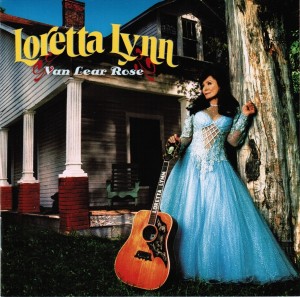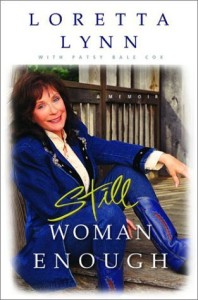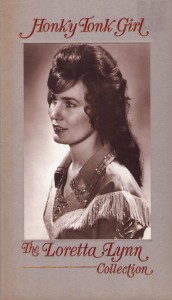
Loretta Lynn – Honky Tonk Girl: The Loretta Lynn Collection MCA MCAD3-11070 (1994)
Loretta Lynn was one of the great country music artists of the post-WWII era, for many reasons. Of course, she could sing. She had a voice that was entirely her own, prone to singing clear lines that melted into vibrato. She was a “coal miner’s daughter” raised in the Butcher Hollow part of Van Lear, Kentucky, and her diction and phrasing was definitely Appalachian, but she didn’t sing with a heavy southern drawl or affected country yodel. She wrote or co-wrote most of her own best songs. Many of them were autobiographical. But a key characteristic was that most of her best material forged a kind of personal independence. In a highly chauvinistic industry, she was able to craft a public persona of a woman in charge, able to make her own way. At a time when other female country singers rarely deviated from songs about romantic heartbreak (your typical country weeper song) or faithfulness, Lynn performed ones like “Fist City” that promised swift retribution for anyone (in that case her childrens’ bus driver) disrupting or undermining her life by chasing after her man — without crossing the line to simply claim her man as her possession she subverts the patriarchal notion of a woman being under the control of a man. One great example of this was an appearance on The Dean Martin Show in which a producer told her Martin would swivel her around and sit her in his lap during a song routine. She told the producer she wouldn’t sit in no man’s lap and that he could get someone else to do the show if that was the condition. They relented and Martin did not touch her during the performance.
Throughout her career she stayed true to her “hillbilly” roots. This isn’t to say she had a haughty, provincial attitude or asserted that rural folk were better than city folk. She instead had a strong sense of where she came from and was unapologetic about the perspective her upbringing gave her. This is epitomized by her hit “Coal Miner’s Daughter,” from her album of the same name, but also the title of both her 1977 memoir and a (rather good) New Hollywood biopic from 1980 starring Sissy Spacek (whom Lynn hand-picked for the role). She has recounted how Ernest Tubb said she was the only person he ever saw who never changed after she became famous.
She got her start as an independent (non-Nashville) act, recording the self-penned single “I’m a Honky Tonk Girl b/w Whispering Sea” in Hollywood (for Canadian label Zero) while she lived in Washington state. She has said her earliest sessions had a distinctive West Coast shuffle, and she recorded her first full-length album Loretta Lynn Sings in Los Angeles, with a subtle rhythmic swing to most of the songs that drew on just a little bit of rock and roll and hinted at the Bakersfield Sound. But one of Loretta Lynn’s greatest strengths — maybe her greatest — was her ability to go into the Nashville system and still make music her own way. She was far from a typical Nashville star, and her feisty persona cut against the grain of what was expected of female country stars (early influences were Kitty Wells and Patsy Cline, along with male role models like Ernest Tubb). Unlike, say, Johnny Cash, who existed kind of apart from the the Nashville system, Lynn worked her way into Nashville, performing on the Grand Ole Opry and such, but turning the Nashville system around for her own purposes, from the inside.
Lots of Lynn’s best songs follow a similar formula. In her earlier recordings she trades verses back and forth with instrumental statements from a pedal steel (Hawaiian) guitar, piano, or other instrument. The other instruments are not merely background accompaniment, but are given moments of roughly equal prominence with her voice. Everything is given its own space, without subjugating one to another. This is actually crucial for what made Loretta Lynn such a unique performer. Without being explicitly and overtly political, it is clear that her music reflected a worldview much to the political left of what Nashville country music typically promoted, seeking a more egalitarian way to “even things out” in society — a view complicated by her later political campaigning for politicians of the political right, due, apparently, just to personal affection. This is why the trading back-and-forth in a kind of call-and-response format suited her songs well. It also should be said that her music doesn’t fall into facile assumptions of the “proper” arrangement of people and things. Even as she implicitly suggests an end to patriarchy, there is more to the structure of her music than a simplistic shift to a differently ordered but essentially similar social hierarchy. In other words, implicitly drawing from christianity, it isn’t that everyone has a proper place. Lynn’s songs are often about the struggles of finding oneself in a particular position and looking for a way toward something else.
On the other hand, there isn’t some kind of reliance on Horatio Alger myths in Lynn’s music. Much like the classical historian Thucydides eschewed supernatural explanations for events in ancient Greece, there is no place for miracles or divine inspiration. The tales in Lynn’s songs are the product of human interactions. The essence is about movement in its most basic form, in relation to other people. Her traded statements with instrumentalists absolutely emphasize this relational aspect. In later years, this relationship was a little less natural. It didn’t disappear completely, but did seem somewhat more forced and the instrumentals more distant from Lynn’s vocals.
She absolutely places family, and her band, at the center of everything. She didn’t accomplish anything all on her own. But family and romantic relationships loom large in terms of the social interactions that preoccupied her songwriting. This is partly why her music is so durable, and as accessible and relatable a half century later as it was the day it was recorded.
Lynn claimed to be apolitical — which is a typical stance of political liberalism. Yet there is no escaping politics. “Dear Uncle Sam” is a war protest song. This is remarkable. Most of what country music had to say about the war can be summed up by Merle Haggard‘s “The Fightin’ Side of Me,” which is not so much a pro-war song as an anti-middle class song. The reality is that the most visible parts of the war protest movement were led by middle class students. Many historians attribute the end of the Vietnam War, that is, American withdrawal from the conflict, to have been precipitated by the draft, when the children of the middle class were forced to bear life and death burdens, not just the lower classes who volunteered. This is sometimes suggested as an explanation for the length and media disinterest in America’s longest war, in Afghanistan, or even the two wars in Iraq, which were all volunteer armies, drawn mostly from the lower classes. As epitomized by the Merle Haggard song, the tendency is to see military service as one of the proud ways that lower classes can provide public service, without much consideration given to that service being for wars of aggression. But Loretta Lynn’s “Dear Uncle Sam” takes a look at the costs borne by the lower classes. It is worth noting that Lynn wrote the song in 1966. The draft lottery for the Vietnam War was not instituted until 1969. When she sings about the personal cost to the protagonist, she is singing about how the burden of the war (of aggression — the relatively poor country of Vietnam posed zero military threat to the United States) fell disproportionately on the poor. This is a sentiment found in other songs of the era. Blues musician JB Lenoir wrote “Vietnam Blues” (released in 1970) from the perspective of war politics being a luxury for a black man suffering from domestic oppression. Then there is Joan Baez with 1973’s “Where Are You Now, My Son?” This was a song with lyrics, “They say that the war is done/ But where are you now my son?,” that seem to inhabit the same space as Lynn’s “Dear Uncle Sam.” But Baez has a shrill, preachy tone (albeit in a song interspersed with field recordings from Vietnam, complete with the sound of bombs in the background). The Baez song, most importantly, speaks primarily to an audience already opposed to the that war, or any other. Lynn, though, was speaking to an audience more in favor of the war, or at least, more indifferent or ambivalent to it.
Other Lynn songs like “Don’t Come Home a Drinkin’ (With Lovin’ on Your Mind),” “Rated X” and “The Pill” — even the Shel Silverstein-written “One’s on the Way” — had a definite feminist slant. The essence of feminism is the radical idea that women are equal to men. When Lynn sings about acting on her own, and making up her own mind, she is usurping a role dictated to women in a patriarchal society.
As time went on, Lynn’s sound changed (though Owen Bradley remained her producer for almost the entirety of her peak popularity). In the late 1960s, as she was fully a part of the Nashville scene, her songs featured more elaborate backing, using reverb, string arrangements and backing singers. Yet she stuck with a honky tonk-inflected style as other styles rose to prominence. Eventually, though, traces of a honky tonk sound were muted. Her music became smoother. The rhythms were softened, and there was generally less space and silence. At the same time her vocals were frequently more staccato. Sometimes her vocals were double-tracked. She still succeeded in this later period with songs like “Love Is the Foundation” and “Trouble in Paradise,” even “Hey Loretta,” “Out of My Head and Back in My Bed“ and the duet “You’re the Reason Our Kids Are Ugly“ too.
Duets with male singers were a significant part of Lynn’s career. Her early mentor Ernest Tubb was her first duet partner, but she later had a successful run of recordings with Conway Twitty that were arguably much better than those with Tubb.
Although few artists ever have a hit, even the few considered successful generally only stay relevant for five to maybe ten years. Loretta Lynn managed to stay relevant and popular for almost two decades, before fading from view somewhat. Granted, Lynn was churning out three to four full-length albums per year during her peak. The pace of her recording schedule virtually guaranteed that those albums would be loaded with filler. So a collection like Honky Tonk Girl does a great service in focusing on mostly the key singles. There are other Lynn collections and “best ofs” available, but many of those omit too much — like her iconic debut single “Honky Tonk Girl.” Granted, Honky Tonk Girl came out in 1994, a decade before her crossover/comeback album Van Lear Rose, so it can’t be a comprehensive overview of her entire career without at least one song (and preferably a handful of songs) from that album like the great “Miss Being Mrs.”
Still, Lynn suffered from a problem of many big stars. She toured way too much, and did too many television appearances, leaving her with too little time devoted to songwriting or recording. There are simple explanations for this trend. Musicians tend to make much more money from live performance than from recordings. The recordings tend to be seen as merely stimulating demand for concerts, and big stars tend to eventually take demand for their concerts for granted — until their fan base dwindles and young people have associated themselves with other, newer acts, perhaps blissfully unaware of the existence of the established acts. So it was with Loretta Lynn — she tried to write about the burdens of fame in her second memoir Still Woman Enough in which she also admits to losing interest in recording. By the 1980s she was recording mostly songs written by others. On top of that, most stars of the 1960s (in any genre) were floundering by the mid-1980s, and country music of that era was at an epic low point. Lynn was caught in those downward trends too. So disc three of Honky Tonk Girl is easily the least of the set, particularly because the second half of it dips in quality.
Honky Tonk Girl is still probably the best Lynn compilation available. Even the so-called The Definitive Collection lacks the iconic “I’m a Honky Tonk Girl”! In Honky Tonk Girl: My Life in Lyrics Lynn states that the song was the first she ever wrote (though elsewhere that honor is credited to the b-side “Whispering Sea”), about a woman who had never drank before but kept coming into the club where Lynn was working, sitting in the same booth and crying after a few beers, because her husband left her and her seven children for a younger woman. The thing about that song, and so many of Lynn’s best, is that it is absolutely genuine. She wrote about what she knew.
Beat writer William S. Burroughs once wrote an article “A Review of the Reviewers” (reprinted in The Adding Machine: Selected Essays), in which he said:
Matthew Arnold set up three criteria for criticism: 1. What is the writer trying to do? 2. How well does he succeed in doing it? … 3. Does the work exhibit “high seriousness”? That is, does it touch on basic issues of good and evil, life and death and the human condition. I would also apply a fourth criterion … Write about what you know. More writers fail because they try to write about things they don’t know than for any other reason.
Loretta Lynn was great because her best recorded work met all four of Burroughs’ criteria.
All said, Honky Tonk Girl is a great collection, and at least the first two discs are about as good as late 20th Century country music comes. Despite not being a complete career-spanning overview, and the lack of a disc-by-disc track listing — only a consecutively numbered list is provided, leaving the listener to guess at whether song number 24 appears on disc one or two, for instance — this is still music to return to often.



